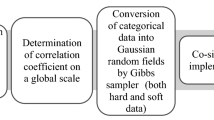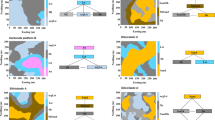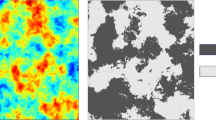Abstract
Some years ago, earth scientists came to realize that knowing more about the geology of an orebody or an oil reservoir makes it easier to make the appropriate decisions concerning mine planning or reservoir exploitation. Geostatistical techniques for simulating lithofacies—that is, the geometry of the geology—were developed as a result of this. These methods should be able to produce geological images that respect not only the anisotropies of the different lithofacies but also their spatial layout relative to one another. While indicator variograms ensure that anisotropies are respected, another tool needs to be incorporated in the simulation technique to reflect the relative spatial layout of the different lithofacies. We propose to use the concept of edge effects that define the position of one lithofacies relative to another. Simple tests using direct and cross indicator variograms confirm the presence or absence of edge effects. We investigate if and how edge effect information can be incorporated in the different indicator simulation techniques—sequential indicator simulations, simulated annealing, the truncated Gaussian method and plurigaussian simulations. Results show that the choice of simulation method must be guided by the edge effect characteristics of the experimental lithologic data.
Similar content being viewed by others
REFERENCES
Aarts, E., and Korst, J., 1989, Simulated annealing and boltzmann machines: JohnWiley & Sons, New York, 328 p.
Alabert, F., 1987, Stochastic imaging of spatial distributions using hard and soft data: unpublished master's dissertation, Stanford University, California, 197 p.
Beucher, H., Galli, A., Le Loc'h, G., Ravenne, C., and the HERESIM Group, 1993, Including a regional trend in reservoir modelling using the truncated Gaussian method, in Soares, A., ed., Geostatistics Troia '92: Kluwer, Dordrecht, p. 555–566.
de Fouquet, C., Beucher, H., Galli, A., and Ravenne, C., 1989, Conditional simulation of random sets. Application to an argilaceous sandstone reservoir, in Armstrong, M., ed., Geostatistics: Proceedings of the Third International Geostatistics Congress, Avignon, France, 5–9 Sept. 1988: Kluwer, Dordrecht, p. 517–530.
Deutsch, C. V., 1992, Annealing techniques applied to reservoir modeling and the integration of geological and engineering (test well) data: unpublished doctoral dissertation, Stanford University, California, 306 p.
Deutsch, C. V., and Journel, A. G., 1992, GSLIB: Geostatistical software library and user's guide: Oxford University Press, New York, 340 p.
Freulon, X., and de Fouquet, C., 1993, Conditioning a Gaussian model with inequalities, in Soares, A., ed., Geostatistics Troia '92: Kluwer, Dordrecht, p. 201–212.
Galli, A., Beucher, H., Le Loc'h, G., Doligez, B., and the HERESIM Group, 1994, The pros and cons of the truncated Gaussian method, in Armstrong, M., and Dowd, P., eds., Geostatistical Simulations: Proceedings of the Geostatistical Workshop, Fontainebleau, France, 27–28 May 1993: Kluwer, Dordrecht, p. 217–233.
Jacod, J., and Joathon, P., 1971, Use of random-generic models in the study of sedimentary processes: Math. Geology, v. 3, no. 3, p. 256–279.
Kerswill, J. A., Henderson, J. R., and Henderson, M. N., 1996, Distribution of gold and sulphides at Lupin, Northwest Territories—A discussion: Econ. Geology, v. 91, no. 5, p. 957–963.
Le Loc'h, G., Beucher, H., Galli, A., Doligez, B., and the HERESIM Group, 1994, Improvement in the truncated Gaussian method: combining several Gaussian functions: in ECMOR IV: 4th European Conference on the Mathematics of Oil Recovery, Røros, Norway, 7–10 June 1994, unpubl. conference proceedings.
Le Loc'h, G., and Galli, A., 1997, Truncated plurigaussian method: theoretical and practical points of view, in Baafi, E. Y., and Schofield, N. A., eds., GeostatisticsWollongong '96: Kluwer, Dordrecht, p. 211–222.
Matheron, G., 1969, Les processus d'Ambarzoumian et leur application en géologie, unpubl. internal report, Centre de Géostatistique, ENSMP, Fontainebleau, 169 p.
Matheron, G., 1989, The internal consistency of models in geostatistics, in Armstrong, M., ed., Geostatistics: Proceedings of the Third International Geostatistics Congress, Avignon, France, 5–9 Sept. 1988: Kluwer, Dordrecht, p. 21–38.
Matheron, G., Beucher, H., de Fouquet, C., Galli, A., Guerrillot, D., and Ravenne, C., 1987, Conditional simulation of the geometry of fluvio-deltaic reservoirs, in SPE 16753, SPE 62nd Annual Conference, Dallas, Texas, September 27–30, p. 571–599.
Rivoirard, J., 1990, Introduction au krigeage disjonctif et à la géostatistique non linéaire, unpubl. course notes, Centre de Géostatistique, ENSMP, Fontainebleau, 84 p.
Rivoirard, J., 1993, Relations between the indicators related to a regionalised variable, in Soares, A., ed., Geostatistics Troia '92: Kluwer, Dordrecht, p. 273–284.
Rivoirard, J., 1994, Introduction to disjunctive kriging and nonlinear geostatistics: Clarendon Press, Oxford, 181 p.
Roth, C., Armstrong, M., Galli, A., and Le Loc'h, G., 1998, Using plurigaussian simulations to reproduce lithofacies with contrasting anisotropies, in Proceedings of the 27th International Symposium APCOM'98: Institution for Mining and Metallury, London, p. 201–214.
Author information
Authors and Affiliations
Rights and permissions
About this article
Cite this article
Roth, C. Incorporating Information About Edge Effects When Simulating Lithofacies. Mathematical Geology 32, 277–300 (2000). https://doi.org/10.1023/A:1007581710372
Issue Date:
DOI: https://doi.org/10.1023/A:1007581710372




